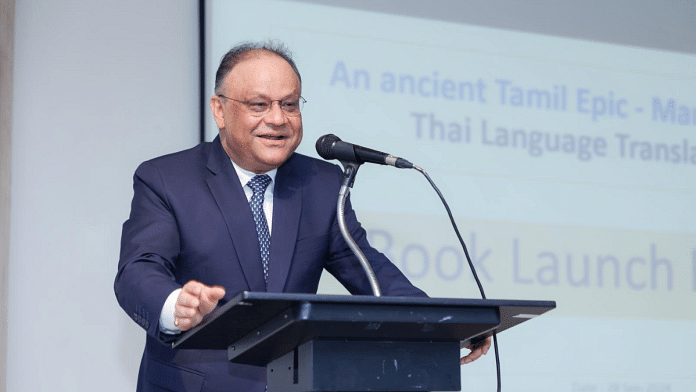New Delhi: India and Thailand are set to elevate their ties to a “strategic partnership,” and are looking to deepen military industrial cooperation, Nagesh Singh, the Indian Ambassador to the Southeast Asian country, said in an exclusive interview with ThePrint Wednesday.
Prime Minister Narendra Modi is set to travel to Bangkok Thursday, for a two-day visit, during which he will hold a bilateral meeting with his Thai counterpart Paetongtarn Shinawatra, and also attend the sixth BIMSTEC (Bay of Bengal Initiative for Multi-Sectoral Technical and Economic Cooperation) summit Friday.
“One area which is now coming up is on defence industrial cooperation. They [Thailand] have been looking at the growth of Indian defence manufacturing and are keen to be a part of this story. Somehow, be a part of this supply chain…Thailand has a very advanced manufacturing sector,” Singh said on the growing strategic ties between the two countries.
Earlier this year, the Chief of Defence Force of the Royal Thai Armed Forces General Songwit Noonpackdee paid an official visit to India from 21 January till 24 January.
The Indian ambassador pointed out how the two countries have been having such high-level defence exchanges in all three services–the Army, Air Force and Navy– for over a decade now. There have been mutual training exercises between the two militaries as well. Most recently in 2023 the two Navies held ‘Exercise Ayutthaya’, their first joint exercise.
“We are likely to sign the strategic partnership agreement, which will lead to us a strategic dialogue between our two National Security Councils,” Singh said. It elevates the ties from operational silos into a larger political setting, which would make decision-making “easier.”
Both India and Thailand face similar non-traditional security challenges, including human trafficking and drug trafficking operating within the Bay of Bengal. Just last month, 549 Indians lured into Myanmar over fake jobs were repatriated to India, with support from Thai authorities.
“For Thailand, it is a big matter of concern. Whenever you have such criminal gangs growing in your neighbourhood, it is a threat to your national security. Whether it is human trafficking, linked to it is the drug trafficking problem…Last month, we evacuated 549 Indians who were brought back to Mae Sot (Thailand),” Singh said.
“India and Thailand have common threat perceptions and common issues. There are Thai people also trafficked into Laos, Myanmar and Cambodia. The Royal Thai government has been very very helpful in facilitating the repatriation of Indians who have been rescued from there. We do have dialogues on counter-terrorism, narcotics and human-trafficking as well, between the two National Security Councils.”
The visit by Modi, is the first bilateral visit by an Indian leader to Thailand in 12 years. In 2016, he briefly stopped over to pay tribute to the late King Rama IX. Three years on, he travelled to Thailand for ASEAN summit and related meetings. while travelling for the 16th ASEAN Summit and related meetings.
The visit comes as India has continued to focus on deepening its relationship with Southeast Asian nations in the last year. The Prime Minister has travelled to Brunei Darussalam, Singapore and Laos since the start of his third term last June.
Thailand, which is the second largest economy in the Association of Southeast Asian Nations (ASEAN), is India’s fourth largest trading partner in the region. A number of challenges remain, which have impacted the economic ties, including market access for Indian businesses and vice versa. Thailand will be India’s fifth strategic partner in the region, following Indonesia, Vietnam, Malaysia and Singapore.
Also Read: Why a BIMSTEC maritime pact has gained fresh importance amid Yunus’s ‘landlocked’ comment
Economic & cultural ties
Trade between the two countries touched about $15 billion last year, according to the Ministry of Commerce and Industry. India was Thailand’s 11th largest trading partner last year, while the Southeast Asian nation was New Delhi’s 21st trading partner, despite the geographic proximity.
In the last two decades, the two countries have focussed on increasing their physical connectivity, through the India-Myanmar-Thailand Trilateral Highway. The project, however, remains unfinished due to the challenging situation in Myanmar. A part of the highway remains to be finished within Myanmar, which has been in the midst of a civil war since February 2021.
“There are issues why the connectivity is poor, and that is why I think the BIMSTEC maritime transport cooperation agreement, which may be signed at this summit, would be helpful. There are tariff and non-tariff barriers, and that is what we are trying to overcome,” Singh said.
“Both countries and both governments are cognisant of the fact that given the size and dynamism of the Indian economy and also the upper middle-income status and advanced manufacturing sector in Thailand, the trade and investment potential is much below what it should be.”
The Indian ambassador, referring to the growing “protectionism” in the world—the looming threat of reciprocal tariffs to be imposed by the US on 2 April—said that there it is imperative for “neighbours” to work together.
The other facet is the long-standing cultural ties. Last year, India had sent the holy relics of Lord Buddha along with that of two of his main disciples, Arahata Sariputra/Arahant Sariputta and Arahata Maudgalyayana/Arahant Maha Moggallana, for public exposition from 22 February to 19 March.
Roughly 4.2 million people devotees from parts of Thailand visited the exposition, as it traversed across four cities–Bangkok, Chiang Mai, Ubon Ratchathani and Krabi. One of the largest draws for Thai tourists to India is to visit the Buddhist holy sites.
(Edited by Tony Rai)
Also Read: Inside Op Brahma: Ships laden with aid en route, field hospital to be airlifted to quake-hit Myanmar






